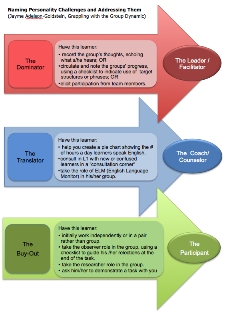|
|

Dena Abramowitz
Author
|
|

Jayme Adelson-Goldstein, Presenter
|
Grappling with the group dynamic is always a challenge in
urban community college classes with wildly heterogeneous student
populations. My classes include professionals alongside students with
just a few years of schooling, refugees from repressive or wartorn
countries along with those who immigrated for good jobs or to join
American spouses, and a mix of races, religions, cultures, and
ages.
Jayme’s session showed me that it’s possible to get such an
assortment of students to participate comfortably in group work if you
break down the tasks into small enough increments, make sure everyone
knows exactly what to do at each moment, and use personal differences to
the advantage of the group.
When I arrived at the workshop, people were milling around in
the aisles waving small numbered cards in various colors. A red card
with a “10” on it was thrust into my hand and within seconds, I was
discussing something with a perfect stranger; a minute later, I was
embroiled in a conversation with a new set of friends. (More on this in a
minute.) Even after we regrouped to discuss what we had done, the room
maintained its friendly atmosphere.
Here are some explanations of this and a few other activities
that I particularly liked and hope to use in my classes.
1. Numbered Cards: Each student is given a colored card with a
number written on it. A few wild cards are in the deck also. Students
use the cards to find partners according to parameters announced by the
teacher. For example, students might be told to find someone with a card
of the same color but with a different number. For the next activity,
they might have to look for someone with the same number on a card of a
different color.
(
Note:
The numbered and colored cards were used
in an adaptation of the cooperative class building activity Deuces
Wild.
)
This helps mix it up in the classroom and avoid the usual
bugbears, like students who insist on being together, those who refuse
to talk to a certain person, or the quiet souls hoping to avoid talking
at all. The teacher can pull out a wild card if there’s an uneven number
of students. Midpoint partner changes can be made quickly, and it’s
easy to assimilate students who arrive late, as I did. (It worked for
me; I participated fully once I had a card in my hand even though I had
no idea what I was doing.)
2. Personality Types: Personalities are divided into classic
types and classroom roles are suggested that make use of their
characteristics. (The session handout includes a list.) Even students
such as the nonparticipator or the inveterate translator, who are often
hard to include in group work and may even be destructive to the group
dynamic, can be given compatible tasks. (See Table 1 for more
information from the session.)
3. Bird Walks: Students are encouraged to wander around to see what the other groups are doing.
This session was a lot of fun and very participatory, which is
exactly what an ESL classroom should be. I’m looking forward to next
semester when I can try out these ideas.

Table 1. Management Challenges and Solutions ([author, or title of work if no author], 2012)
|
Naming the Management Challenge |
Addressing the Challenge |
|
Ties That Bind: Students want to work with the same
people (or person) for each task. They are reluctant to pair or work in
groups with unknown members of the class. |
* Build community so that all students know each
other. This can be done by using mixing activities such as surveys,
interactive bingo, “find someone who…”, mix-and-match card games (match
shapes, puzzle pieces, images), or 4-Corners. Be sure to include an
introduction and meaningful exchange between the students with each
activity. |
|
Territorial Imperative: Students do not want to
leave their seats to move into group or pair configurations. Students
may be concerned about the security of their things or feel
uncomfortable leaving their space. |
* Provide perimeter activities where learners meet
in groups away from their desks: in corners, near tearsheets posted on
the wall, even outside the classroom.
* Set up group areas before students come into class and give
each person a card that matches the card in the group area. (Allows them
to be in their group from the beginning of class.) |
|
Time Spectrum: Group 1 completes the 15-minute task
in 5 minutes, groups 2 and 3 are on schedule, and groups 5 and 6 will
never finish in the allotted timeframe. |
* Assign a timekeeper for each group to help groups stay on task.
* Check in at the halfway point to see if the time limit needs adjusting.
* Have a two-part “What’s Next” task ready at all times. In
this way groups that finish early have a follow-up task; those that
finish on time can complete the first part of the task.
* For the slower groups, at the halfway mark, help them
prioritize the most important elements of the task and attack those.
This group can work beyond the time limit while the rest of the class
completes the first follow-up task. |
|
Report-Back from Hell: Lengthy report backs from the
class. For example, six groups all reporting back on their brainstorm
takes six times the amount of time the original task took. |
* Have each group share only one item from the task.
* Have groups compare their task results to a projection (LCD,
OHP) of possible results and report back only on results that were
different.
* Have the group with the least number of items report first.
* Have each group post its results around the room and then
have the groups take a “bird walk” to view each group’s work.
* Have an ambassador from each group tour the other groups to
report on his or her group’s results. The class then discusses the most
interesting, the most unusual, or the most creative, etc.,
result. |
REFERENCE
Adelson-Goldstein, J. (2012). Grappling With the Group Dynamic. Lighthearted Learning.
Dena Abramowitz teaches ESL at Milwaukee Area
Technical College. Her students come from over 70 countries and speak
languages most people have never heard of, and she is always looking for
ways to get them to talk―and listen―to each other. Ms. Abramowitz
earned her master’s degree in linguistics from UCLA.
Jayme Adelson-Goldstein is a professional development
specialist, materials writer, and long-time member of the ELT community.
She teaches in TESOL's online core certificate program and edits the
Materials Writers IS Newsletter. |

